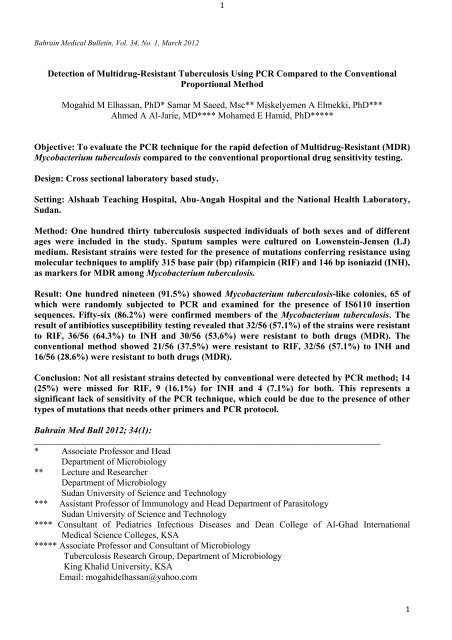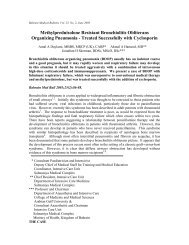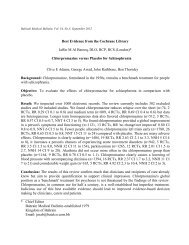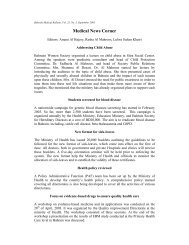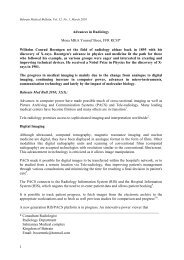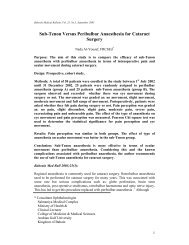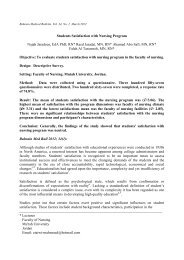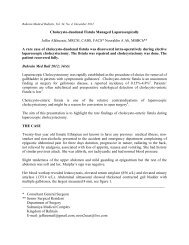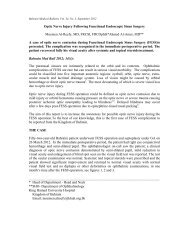Full (127 KB) - Bahrain Medical Bulletin
Full (127 KB) - Bahrain Medical Bulletin
Full (127 KB) - Bahrain Medical Bulletin
Create successful ePaper yourself
Turn your PDF publications into a flip-book with our unique Google optimized e-Paper software.
<strong>Bahrain</strong> <strong>Medical</strong> <strong>Bulletin</strong>, Vol. 34, No. 1, March 2012<br />
1<br />
Detection of Multidrug-Resistant Tuberculosis Using PCR Compared to the Conventional<br />
Proportional Method<br />
Mogahid M Elhassan, PhD* Samar M Saeed, Msc** Miskelyemen A Elmekki, PhD***<br />
Ahmed A Al-Jarie, MD**** Mohamed E Hamid, PhD*****<br />
Objective: To evaluate the PCR technique for the rapid defection of Multidrug-Resistant (MDR)<br />
Mycobacterium tuberculosis compared to the conventional proportional drug sensitivity testing.<br />
Design: Cross sectional laboratory based study.<br />
Setting: Alshaab Teaching Hospital, Abu-Angah Hospital and the National Health Laboratory,<br />
Sudan.<br />
Method: One hundred thirty tuberculosis suspected individuals of both sexes and of different<br />
ages were included in the study. Sputum samples were cultured on Lowenstein-Jensen (LJ)<br />
medium. Resistant strains were tested for the presence of mutations conferring resistance using<br />
molecular techniques to amplify 315 base pair (bp) rifampicin (RIF) and 146 bp isoniazid (INH),<br />
as markers for MDR among Mycobacterium tuberculosis.<br />
Result: One hundred nineteen (91.5%) showed Mycobacterium tuberculosis-like colonies, 65 of<br />
which were randomly subjected to PCR and examined for the presence of IS6110 insertion<br />
sequences. Fifty-six (86.2%) were confirmed members of the Mycobacterium tuberculosis. The<br />
result of antibiotics susceptibility testing revealed that 32/56 (57.1%) of the strains were resistant<br />
to RIF, 36/56 (64.3%) to INH and 30/56 (53.6%) were resistant to both drugs (MDR). The<br />
conventional method showed 21/56 (37.5%) were resistant to RIF, 32/56 (57.1%) to INH and<br />
16/56 (28.6%) were resistant to both drugs (MDR).<br />
Conclusion: Not all resistant strains detected by conventional were detected by PCR method; 14<br />
(25%) were missed for RIF, 9 (16.1%) for INH and 4 (7.1%) for both. This represents a<br />
significant lack of sensitivity of the PCR technique, which could be due to the presence of other<br />
types of mutations that needs other primers and PCR protocol.<br />
<strong>Bahrain</strong> Med Bull 2012; 34(1):<br />
____________________________________________________________________________<br />
* Associate Professor and Head<br />
Department of Microbiology<br />
** Lecture and Researcher<br />
Department of Microbiology<br />
Sudan University of Science and Technology<br />
*** Assistant Professor of Immunology and Head Department of Parasitology<br />
Sudan University of Science and Technology<br />
**** Consultant of Pediatrics Infectious Diseases and Dean College of Al-Ghad International<br />
<strong>Medical</strong> Science Colleges, KSA<br />
***** Associate Professor and Consultant of Microbiology<br />
Tuberculosis Research Group, Department of Microbiology<br />
King Khalid University, KSA<br />
Email: mogahidelhassan@yahoo.com<br />
1
2<br />
The most effective anti-TB drugs are isoniazid (INH) and rifampicin (RIF). Resistant Mycobacteria to<br />
at least one of these drugs are the cause of Multidrug-resistant tuberculosis (MDR-TB). This type of<br />
resistance is highly problematic due to limited sources of drugs as well as the high toxicity, low<br />
efficacy and high cost of second-line tuberculosis drugs 1 .<br />
In 2008, an estimated 390,000 - 510,000 cases of MDR-TB emerged globally. Among TB cases, 3.6%<br />
are estimated to have MDR-TB. Twenty-two of 48 African countries reported first-line TB drug<br />
resistance, the estimated number of MDR-TB cases (primary and acquired) in 2008 was 69,000<br />
(53,000 - 110,000) 2 .<br />
Since the early study by Cavanagh, data on drug resistant TB are lacking in the Sudan 3 . Tuberculosis<br />
control program in Khartoum 2006 showed that there was no system to detect the prevalence of MDR-<br />
TB or HIV among the TB cases 4 .<br />
Although the rate of drug resistance is continuously increasing, only around 7% of estimated cases are<br />
detected. The control of drug resistant disease is difficult especially in high burden countries due to<br />
poor laboratory services and the slow nature of conventional drug susceptibility testing 5 .<br />
Therefore, implementation of rapid molecular methods for detecting drug-resistant TB may be a viable<br />
alternative to culture-based DST. Recently the WHO recommended the use of molecular techniques<br />
such as Line probe assay (LPA) for rapid screening of MDR-TB in low and middle-income settings 6 .<br />
The role of mycobacterial catalase-peroxidase gene (katG) was determined by cloning and sequencing<br />
of this gene. Mutations in this gene were found in 42 - 58% of isoniazid-resistant clinical isolates,<br />
confirming the effect of KatG enzyme in INH activity 7 .<br />
Other mutations were detected in Ser315Thr, about 40% of isoniazid-resistant strains 8 . This mutation<br />
was found to result in the production of a catalase enzyme that retains about 50% of isoniazid catalaseperoxidase<br />
activity, which is sufficient for the ability of the organism to evade the action of host active<br />
radicals 9 .<br />
Spontaneous mutations (deletions/substitutions/insertions) were found to occur in the 81-bp hotspot<br />
region of the rpoβ gene which encodes DNA-dependent RNA polymerase (the target for rifampicin<br />
binding); this result into replacement of the aromatic with non-aromatic amino acids in the target RNA<br />
polymerase enzyme, which consequently leads to poor bonding between rifampicin and the RNA<br />
polymerase 10,11 .<br />
The aim of this study is to evaluate the PCR technique for the rapid defection of MDR Mycobacterium<br />
tuberculosis in comparison to the conventional proportional drug sensitivity testing.<br />
METHOD<br />
Randomized prospective cross sectional study was performed. Smear-positive sputum was collected<br />
from 130 patients with persistent tuberculosis. Informed consent was obtained from each patient. The<br />
study was approved by the Federal Ministry of Health and the ethical committee of the Scientific<br />
Research Council of Sudan University of Science and Technology.<br />
Sputum samples were screened for acid-fast bacilli (AFBs) using Ziehl-Neelsen (ZN) smear<br />
microscopy. Handling and processing of specimens were performed in biosafety cabinet (BSL 3).<br />
Sputum was processed with the N-acetyl-L-cysteine-sodium hydroxide (NaOH) method (NaOH final<br />
concentration, 1.5%) and cultured in Lowenstein-Jensen (LJ) slants. Isolation and conventional<br />
identification of Mycobacterium tuberculosis were performed following standard method 12 . Drug<br />
susceptibility testing was performed by LJ proportion method 13 .<br />
2
3<br />
Sixty-five Mycobacterium tuberculosis isolates were randomly selected from the positive cultures and<br />
were confirmed as Mycobacterium tuberculosis by detecting species-specific IS6110 (123 bp) using<br />
primers and method previously described 14 . Resistant strains detected by conventional methods were<br />
tested for the presence of mutations conferring resistance to isoniazid (INH) and rifampicin (RIF)<br />
using PCR method.<br />
SPSS for windows version 11.0 was used for data analysis.<br />
RESULT<br />
One hundred thirty sputum specimens from patients were examined, 82 males and 48 females, age<br />
range was 12 to 67 years, 119 (91.5%) showed Mycobacterium tuberculosis-like colonies, 65 were<br />
randomly subjected to PCR and examined for the presence of IS6110 insertion sequences. PCR<br />
revealed that 56 (86.2%) were Mycobacterium tuberculosis and 9 (13.8%) were MOTTs, see table 1<br />
and figure 1.<br />
Table 1: Susceptibility Testing of IS6110 Positive Mycobacterium Tuberculosis for Rifampicin<br />
and Isoniazid by Proportion Method Compared to Multiplex PCR Method<br />
LJ proportion method PCR method<br />
RIF INH<br />
Number (%)<br />
RIF INH<br />
Number (%)<br />
Resistant 32 (57.1%) 36 (64.3%) 21 (37.5%) 32 (57.1%)<br />
Sensitive 23 (41.1%) 19 (33.9%) 35 (62.5%) 24 (42.9%)<br />
ND 1 (1.8%) 1 (1.8%) - -<br />
Total 56 56 56 56<br />
Figure 1: PCR Amplified IS6110 Sequences, Lane 1, DNA Marker; Lane 2, Negative Control;<br />
Lane 3, Reference Mycobacterium Tuberculosis Strain H37v (Positive Control)<br />
Antibiotics susceptibility testing revealed that 32/56 (57.1%) of the strains were resistant to RIF using<br />
the conventional proportion method compared to 21/56 (37.5%) using PCR method. Resistant for INH<br />
were 36/56 (64.3%) using the conventional method compared to 32/56 (57.1%) using PCR method;<br />
51.8% of the strains were found resistant for both drugs (MDR) using the conventional method<br />
compared to 28.6% for both drugs (MDR) using the PCR method, see figures 2 and 3.<br />
3
4<br />
Figure 2: The Amplicon of Rifampicin Resistant Mycobacterium Tuberculosis; Lane 1, DNA<br />
Marker; Lane 2, Negative Control; Lane 3, Positive Control; Lane 7; RIF Resistant Strain<br />
Figure 3: The Amplicon of Isoniazid Resistant Mycobacterium Tuberculosis; Lane 1, DNA<br />
Marker; Lane 2, Negative Control; Lane 3, Positive Control; Lanes 4 And 7, INH Resistant<br />
Strains<br />
DISCUSSION<br />
The result of antibiotics susceptibility testing revealed that there were obvious differences between the<br />
conventional and PCR method, this may be due to the presence of resistant mutations, which could not<br />
be detected using current primers.<br />
It was noticed that the majority of the isolates, which showed resistance to the two drugs on LJ<br />
medium proportion method showed resistance on the PCR to the two drugs or at least to one of them,<br />
mostly isoniazid; therefore, resistance to Isoniazid can be considered as a marker for multidrug<br />
resistance 15 . However, Sharma et al considered resistance to rifampicin as a marker for MDR TB 16 .<br />
In this study, a rising resistance rates of MDR among TB patients in Sudan compared with some<br />
African countries were revealed. In Ethiopia 14% of the isolates were found MDR, in Kenya 33.3%, in<br />
South Africa 60.2% and in Saudi Arabia 11% resistance to isoniazid and 9.7% to rifampicin was<br />
recorded 17-20 . In the present study, a rate of 21.5% was detected, which could be compared to Sharaf el<br />
Din et al who applied PCR based dot-blot method and found that 12% of strains were resistant to INH<br />
(katG gene), 8% were resistant to RIF (rpoB gene), 30% to STM (rpsl gene) and 4% to EMB (embB<br />
gene) but no record of MDR was investigated by these authors in patients with persistent TB 21 .<br />
Similarly, a novel PCR-based reverse hybridization method Genotype MTBDR assay (Hain<br />
Lifescience GmbH, Nehren, Germany) was evaluated for rapid detection of rifampicin (RIF) and<br />
isoniazid (INH) resistance in Turkish Mycobacterium tuberculosis isolates revealed that RIF resistance<br />
4
5<br />
was correctly identified in 95.1% of the isolates and in 73% of INH-resistant isolates. However, the<br />
recommendation of the author is to confirm the result with phenotypic methods 22 .<br />
The GenoType® MTBDRplus assay has been validated as a rapid and reliable first-line diagnostic test<br />
on AFB-positive sputum or MTB isolates for INH resistance, RIF resistance and MDR-TB in<br />
Bangkok, it was found reliable, but its impact on treatment outcome, feasibility and the cost associated<br />
with widespread implementation needs to be evaluated 23 .<br />
The presence of some isolates in this study, which are sensitive in the proportional method and<br />
appeared as resistant in the PCR to one of the two drugs or both of them could not be attributed to<br />
contamination, rather it could be due to mutations, which are not necessarily strongly related to<br />
resistance. Moreover, since the target region of the genes for RIF and INH resistance are not<br />
mentioned by the manufacturer, it is difficult to explain this part of the result.<br />
CONCLUSION<br />
Classical DST is still a gold standard method for diagnosis of MDR TB in developing countries.<br />
However, substitution of the classical DST with the rapid and sensitive PCR needs to be<br />
carefully evaluated as the protocol used in this study failed to detect all types of mutations<br />
present. Other PCR protocols targeting all known mutations in RIF and INH genes could be of<br />
more useful.<br />
___________________________________________________________________________<br />
Author contribution: All authors share equal effort contribution towards (1) substantial contributions<br />
to conception and design, acquisition, analysis and interpretation of data; (2) drafting the article and<br />
revising it critically for important intellectual content; and (3) final approval of the manuscript version<br />
to be published. Yes<br />
Potential conflicts of interest: No<br />
Competing interest: None Sponsorship: None<br />
Submission date: 30 March 2011 Acceptance date: 2 January 2012<br />
Ethical approval: The study was approved by the ethical committee of Federal Ministry of Health<br />
and the ethical committee of research council of Sudan University of Science and Technology.<br />
REFERENCES<br />
1. Migliori GB, Lange C, Girardi E, et al. Extensively Drug-resistant Tuberculosis Is Worse than<br />
Multidrug-Resistant Tuberculosis: Different Methodology and Settings, Same Results. Clin<br />
Infect Dis 2008; 46(6): 958-9.<br />
2. World Health Organization (WHO). Multidrug and Extensively Drug-resistant TB (M/X DR-<br />
TB): 2010 Global Report on Surveillance and Response. http://whqlibdoc.who.int/publications<br />
/2010/9789241599191eng.pdf. Accessed 17.2.2011.<br />
3. Cavanagh P. The Sensitivity to Streptomycin, PAS and Isoniazid of Strains of Myco.<br />
Tuberculosis Isolated from Patients in Khartoum and Wad Medani. Tubercle 1965; 46(3): 250-<br />
5.<br />
4. Ahmed Suleiman MM, Aro AR, Sodemann M. Evaluation of Tuberculosis Control Programme<br />
in Khartoum State for the Year 2006. Scand J Public Health 2009; 37(1): 101-8.<br />
5
6<br />
5. World Health Organization (WHO). Use of liquid TB Culture and Drug Susceptibility Testing<br />
(DST) in Low and Medium Income Settings. Summary Report of the Expert Group Meeting on<br />
the Use of liquid Culture Media. http://www.who.int/tb/laboratory/ use_of_liquid_tb_culture_<br />
summary_report.pdf. Accessed 25.1.2011.<br />
6. World Health Organization (WHO). Molecular line Probe Assays for Rapid Screening of<br />
Patients at Risk of Multidrug-Resistant Tuberculosis (MDR-TB): Policy Statement. Geneva,<br />
World Health Organization, 2008. http://www.who.int/tb/laboratory/1papolicy. pdf. Accessed<br />
12.2.2011.<br />
7. Somoskovi A, Parsons LM, Salfinger M. The Molecular Basis of Resistance to Isoniazid,<br />
Rifampin, and Pyrazinamide in Mycobacterium Tuberculosis. Respir Res 2001; 2(3): 164-8.<br />
8. Marttila HJ, Soini H, Eerola E, et al. A Ser315Thr Substitution in KatG is Predominant in<br />
Genetically Heterogeneous Multidrug-resistant Mycobacterium Tuberculosis Isolates<br />
Originating from the St. Petersburg Area in Russia. Antimicrob Agents Chemother 1998; 42(9):<br />
2443-5.<br />
9. Rouse DA, DeVito JA, Li Z, et al. Site-directed Mutagenesis of the katG Gene of<br />
Mycobacterium Tuberculosis: Effects on Catalase-peroxidase Activities and Isoniazid<br />
Resistance. Mol Microbiol 1996; 22(3): 583-92.<br />
10. Goble M, Iseman MD, Madsen LA, et al. Treatment of 171 Patients with Pulmonary<br />
Tuberculosis Resistant to Isoniazid and Rifampin. N Engl J Med 1993; 328(8): 527-32.<br />
11. Telenti A, Imboden P, Marchesi F, et al. Detection of Rifampicin-Resistance Mutations in<br />
Mycobacterium Tuberculosis. Lancet 1993; 341(8846): 647-50.<br />
12. Public Health Mycobacteriology, A Guide for a Level III laboratory. US Department of Health<br />
and Human Services, Public Health Service, Centers for Disease Control. USA: Atlanta, 1985:<br />
159-184.<br />
13. National Committee for Clinical Laboratory Standards (NCCLS). Susceptibility Testing of<br />
Mycobacteria, Nocardiae, and Other Aerobic Actinomycetes; Approved Standard; NCCLS<br />
document M24-A [ISBN 1-56238-500-3]. NCCLS, 940 Pennsylvania, USA: 2003.<br />
http://www.iso90.ir/phocadownload/csli/M24-A.pdf Accessed 17.3.2011.<br />
14. Eisenach KD, Cave MD, Bates JH, et al. Polymerase Chain Reaction Amplification of a<br />
Repetitive DNA Sequence Specific for Mycobacterium Tuberculosis. J Infect Dis 1989; 161(5):<br />
977-81.<br />
15. Vijdea R, Stegger M, Sosnovskaja A, et al. Multidrug-resistant Tuberculosis: Rapid Detection<br />
of Resistance to Rifampin and High or Low Levels of Isoniazid in Clinical Specimens and<br />
Isolates. Eur J Clin Microbiol Infect Dis 2008; 27(11): 1079-86.<br />
16. Sharma SK, Mohan A. Multidrug-resistant Tuberculosis. Indian J Med Res 2004; 120(4): 354-<br />
76.<br />
17. Bruchfeld J, Aderaye G, Palme IB, et al. Molecular Epidemiology and Drug Resistance of<br />
Mycobacterium Tuberculosis Isolates from Ethiopian Pulmonary Tuberculosis Patients with and<br />
without Human Immunodeficiency Virus Infection. J Clin Microbiol 2002; 40(5): 1636-43.<br />
18. Githui WA, Jordaan AM, Juma ES, et al. Identification of MDR-TB Beijing/W and Other<br />
Mycobacterium Tuberculosis Genotypes in Nairobi, Kenya. Int J Tuberc Lung Dis 2004; 8(3):<br />
352-60.<br />
19. Calver AD, Falmer AA, Murray M, et al. Emergence of Increased Resistance and Extensively<br />
Drug-Resistant Tuberculosis Despite Treatment Adherence, South Africa. Emerg Infect Dis<br />
2010; 16(2): 264-71.<br />
20. Alrajhi AA, Al-Barrak AM. Mycobacterium Tuberculosis Susceptibility in Saudi Arabia. Saudi<br />
Med J 2002; 23(10): 1227-31.<br />
21. Sharaf-Eldin GS, Saeed NS, Hamid ME, et al. Molecular Analysis of Clinical Isolates of<br />
Mycobacterium Tuberculosis Collected from Patients with Persistent Disease in the Khartoum<br />
Region of Sudan. J Infect 2002; 44(4): 244-51.<br />
22. Cavusoglu C, Turhan A, Akinci P, et al. Evaluation of the Genotype MTBDR Assay for Rapid<br />
Detection of Rifampin and Isoniazid Resistance in Mycobacterium Tuberculosis Isolates. J of<br />
Clin Microbiol 2006; 44(7): 2338-42.<br />
6
7<br />
23. Anek-Vorapong R, Sinthuwattanawibool C, Podewils LJ, et al. Validation of the GenoType®<br />
MTBDR Plus Assay for Detection of MDR-TB in a Public Health Laboratory in Thailand.<br />
BMC Infect Dis 2010; 10: 123.<br />
7


